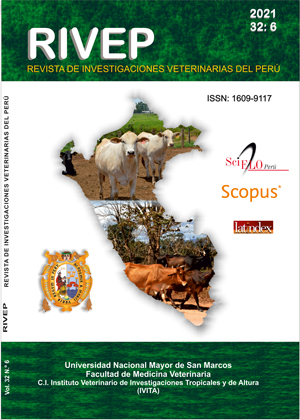Isolation and characterization of mesenchymal stem cells derived from horse synovial liquid presenting the STRO-1 surface marker
DOI:
https://doi.org/10.15381/rivep.v32i6.21682Keywords:
mesenchymal stem cells, MSC, horse synovial fluid, biomarker, STRO-1, OCT4, NANOGAbstract
The biological properties of mesenchymal stem cells (MSCs) from synovial fluid from horse limb joints were analysed. The samples were characterized by their peculiarity of adhering to the plastic of the culture flasks. The electromagnetic field technique (MACS) and the surface biomarker STRO-1 were used to optimize their isolation by enriching mesenchymal precursor cells (MSC-LS). To determine the expression of multipotency genes, total RNA was extracted and M-MLV reverse transcriptase was used for the cDNA, which served as a template for qPCR (quantitative PCR). qPCR was performed using the BioRad system with Sybr Green quantification. The multipotency genes quantified were OCT4 and NANOG. The cells selected using MACS with the surface biomarker STRO-1 (CMM-LS STRO-1) proliferate more rapidly than the CMM-LS obtained without purification. In addition, they showed a greater predisposition to differentiate into chondrocytes and osteocytes compared to non-purified LS-MSCs, and a lower predisposition to differentiate into adipocytes. Likewise, the expression of OCT-4 was significantly higher in the CMM-LS STRO-1 compared to the non-purified CMM-LS. NANOG expression was slightly higher in STRO-1 CMM-LS, but without significant differences. The results suggest that the co-expression of OCT-4 and Nanog could increase the physiological functions of MSC-LS STRO-1 related to better proliferation, self-renewal, and the predisposition to differentiate in osteochondral lineages; however, the functional role of these pluripotency markers in adult stem cells needs to be clarified.
Downloads
Downloads
Published
Issue
Section
License
Copyright (c) 2021 Hugo Gonzales Figueroa, Yat Sen Wong, Hugo Mauricio Gonzales Molfino, José Luis Llanos Carrillo

This work is licensed under a Creative Commons Attribution 4.0 International License.
AUTHORS RETAIN THEIR RIGHTS:
a. Authors retain their trade mark rights and patent, and also on any process or procedure described in the article.
b. Authors retain their right to share, copy, distribute, perform and publicly communicate their article (eg, to place their article in an institutional repository or publish it in a book), with an acknowledgment of its initial publication in the Revista de Investigaciones Veterinarias del Perú (RIVEP).
c. Authors retain theirs right to make a subsequent publication of their work, to use the article or any part thereof (eg a compilation of his papers, lecture notes, thesis, or a book), always indicating the source of publication (the originator of the work, journal, volume, number and date).










